Peony care in autumn
In general, peonies are considered to be quite unpretentious plants. They only need systematic watering, weeding, loosening of the soil and top dressing, as a result of which you will be pleased with a wonderful rich flowering in the summer. It is believed that the main care is carried out during the period of active growth and flowering of flowers. However, peonies are perennial plants, therefore, with the arrival of autumn, they will need special care, which is a guarantee that pink, yellow, bronze or burgundy buds will bloom on your flowerbed next summer. Therefore, we will tell you what to do with peonies in the fall, how to prepare them for the winter cold.
Autumn peony care: feeding
Since peonies respond well to fertilization, it is necessary to feed the peonies in the fall. It is recommended to do this in September or early October. The fact is that in these garden pets, the root system has a number of growth and structural features. In some areas, the roots of peonies thicken, it is there that the necessary nutrients accumulate, which are delivered by long roots that penetrate deeply into the soil. The roots of peonies continue to grow in the first half of autumn, which is why additional feeding is so necessary for the plants.
If we talk about how to feed peonies in the fall, then it is usually recommended to use potassium-phosphorus fertilizer, which will contribute to the development of new buds. Stimulating them means a beautiful bloom next year. Feeding can be done in dry and liquid form. In the first case, 15-20 g of phosphorus and 10-15 g of potassium should be carefully sprinkled on the soil near each bush. Do not forget to water the peony well beforehand. Make sure that the fertilizer does not get on the neck of the peony. To prepare the solution in a bucket of water, dissolve 1 tablet of fertilizer and pour the bush with this solution.
Caring for peonies in the fall: pruning and preparing for winter
Basically, autumn care for peonies involves pruning the shoots. It is required before winter. If you leave the pruning for the spring, it will be difficult for you: softened shoots are difficult to prune with pruners. As a rule, it should be carried out in late autumn, at the end of October - at the beginning of November. The fact is that if you do this earlier, the plants will become weaker, and this, in turn, will affect its flowering next year. Such pruning of peonies in the fall is recommended to be performed after the first frost appears, when the peony shoots begin to lie on the soil.
When pruning your favorite flowers, the shoots should be cut at ground level so that no stumps remain. If you intend to prune peonies in the fall in dry weather, do not forget to water the root area of the soil abundantly. All cut off shoots and leaves must be removed from the lawn and burned, as they can become a source of various diseases. Many gardeners advise, after pruning, to add a mixture of 200 g of bone meal and 300 g of wood ash to the soil.
How to care for peonies in the fall: preparing for winter
In the autumn care of these garden flowers, it is important to prepare for severe frosts. This is recommended for regions where. Carrying out such necessary measures for the care of peonies in the fall is the key to beautiful flowering in the summer.
Carrying out such necessary measures for caring for peonies in the fall is the key to beautiful flowering in the summer.
.
Storing peonies in a vase
Before installing the flowers in a container with water, they are placed in a darkened place with a low temperature.This method will "revive" them a little.
- To prevent bacteria from developing in the water, it is better to use an opaque glass container. Before storing cut peonies in any container, it is washed with water with the addition of potassium permanganate.
- Water quality plays an important role. If she was recruited from the tap, she definitely needs to settle. Rain or spring water is best.
- Storing cut peonies in a vase will last a long time if you remove the lower leaves from the stems. In this case, the stems should be in the water up to half.
- Cuts need to be refreshed using a blade or a well-sharpened knife. They are made obliquely to increase the area of moisture absorption. At the same time, the sections are renewed in water so that air bubbles do not interfere with the movement of moisture along the stems.
- The water in the vase should be replaced with fresh water every day (as a last resort - every 2 to 3 days).
- It is good when peonies are stored at night at low temperatures. First, they are taken out of the vase and wrapped in damp paper.
- If any flower from the bouquet begins to dry out, it must be removed.

A few tips for keeping peonies in a vase
In the place where the flowers are located, too high a temperature is not permissible. In this case, the lighting should be dim. Moreover, you cannot leave the bouquet on a sunny windowsill. There it will not be able to be stored for a long time. You should also avoid the proximity of peonies with fruits and heating devices, and they are also afraid of drafts.
Being in a warm room, flowers begin to bloom faster. But if this process needs to be slowed down, they create coolness or even place flowers on the shelf of the refrigerator.
The smell that comes from peonies can be intensified. The bouquet is covered overnight with a plastic bag, and in the morning it is removed.
The shelf life of cut peonies under normal conditions is 2 - 2.5 weeks.
Preparing for winter
During the summer, the flowers are watered, but they need most of the moisture during the flowering period. Further, the number and volume of irrigations are gradually reduced, slowly bringing them to zero. The point of gradualness is important here. And in the fall, most often only rains are enough. Dry autumn is more likely to prepare plants for a dormant period.
In the fall, new bushes are planted on the site, those that are already growing on it are transplanted, if necessary, adult plants are divided, simultaneously reproducing and rejuvenating peonies. But to prepare them for winter means cutting off the deciduous mass, making the last autumn dressings, and insulating them in anticipation of cold weather. Everything needs to be done correctly and in a timely manner.
Pruning peonies
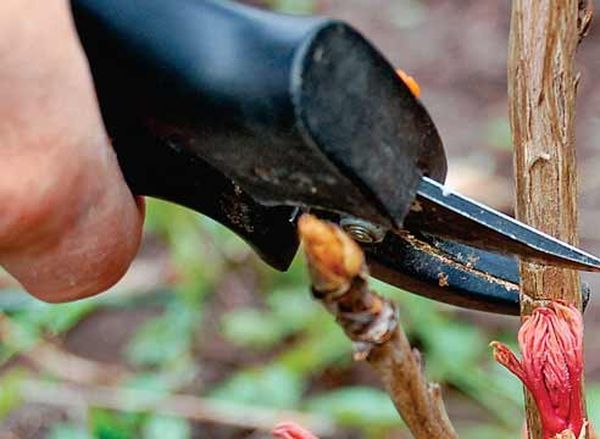
In the fall, it is imperative to cut off all the stems with leaves, since they will inevitably wither, then rot. Pests can settle in them for wintering, the decaying leaves themselves usually become a breeding ground for pathogenic microorganisms. If some kind of infection (often fungal) nestled on them in the summer, but did not cause a visible disease, then next season it will inevitably hit the plant and spread to others. For the good of your entire plot, pruning should not be postponed until spring.
Timing of pruning plants for the winter
In summer, as a rule, only fading flowers are cut, and the leaves continue to perform their decorative function on the site. The roots grow until the very cold, accumulate strength for subsequent flowering, and the process of photosynthesis in the leaves actively helps them. Therefore, it is necessary to cut off the green mass when this process is naturally inhibited. The ideal time is after the first frost, when the leaves fall to the ground.
If for some reason you need to cut the peony earlier, you should leave several leaves on each stem so that the plant can further assimilate nutrients without stopping photosynthesis completely. Depending on the beginning of winter, pruning is carried out approximately from mid-September to mid-October.
Peony pruning scheme
Herbaceous peonies are cut with a sharp disinfected pruner almost at the very ground, leaving only a couple of centimeters from the twigs. It is better to destroy all cut greens by taking them away from the site. It is not suitable for compost due to possible contamination.
If you leave high hemp of the stems, they will dry out, but they can become a breeding ground for pathogenic bacteria, therefore they are usually cut so low that the subsequent hilling will completely hide the bush from the eyes.
Care and feeding after pruning
After pruning, the ground around the bush is freed from all leaves, branches, grass, it is loosened with special tools not very deeply so as not to damage the roots. This is the best time for the last fertilization of the plant. You can use any ready-made complex fertilizers containing potassium and phosphorus. Some growers prefer to make bone meal with wood ash. The main thing is that you do not need to use nitrogen-containing fertilizers, so as not to inadvertently provoke the growth of new shoots, which will inevitably freeze.
Fertilizers can be scattered around the bush, loosening will mix them with the ground, and subsequent rains will carry to the root. If the autumn is dry, then it is better to dilute them according to the instructions and pour about 1 liter under each bush.
Diseases and pests of the tree peony
The tree peony is more resistant to disease than its herbaceous counterpart. The only significant threat can be gray rot, the development of which is facilitated by excess moisture. In this case, the affected leaves must be immediately removed and burned, and the plant itself must be treated with a solution of copper sulfate or potassium permanganate.
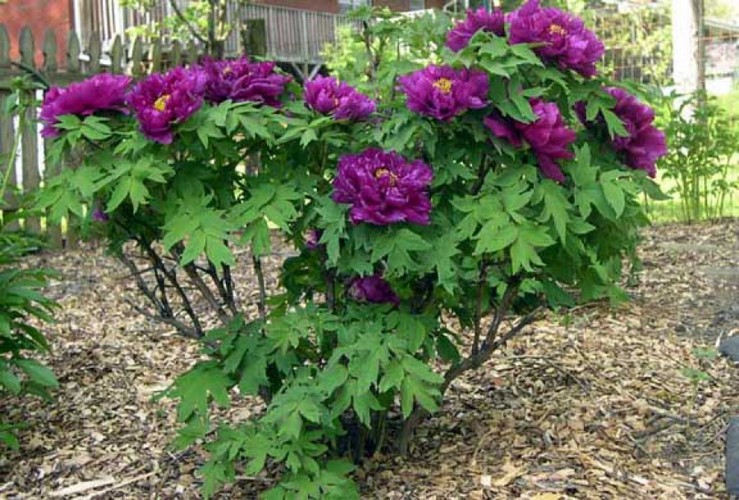
If you want to have a spectacular and unusual perennial plant on your site, then let it be a tree peony. Preparing for winter and caring for it will not take much time, and the unusual appearance and bright flowers will delight the eyes and surprise guests. It can be planted both as single bushes and in group planting, for example, with ordinary herbaceous peonies. And let the shrub saplings are quite expensive, but its perennial flowering more than compensates for all the costs.
How to store cannes in winter
In order for the tubers to winter safely, they need to provide a comfortable environment. Cannes can be stored in several ways:
- in the basement, cellar or refrigerator in the form of dried tubers;
- at rest in a flower pot;
- as a houseplant.
In all cases, the tubers are carefully dug out with a sharp shovel so as not to damage the roots. This is done in dry and warm weather.
How to store cannes in the winter in a basement or cellar
The leaves of the plant are pruned to a height 15-20 cm, the tubers are slightly shaken off, but the soil is not completely removed. Then they are dried under a canopy in the fresh air, after which they are placed in a wooden box filled with moist peat mixed in equal proportions with sand and sawdust. A box with tubers is stored in the basement and cellar with an air temperature of 5-7 ° C and a humidity of no more than 60%.
About once a month, the tubers are inspected and slightly moistened the substrate as it dries. If rotten places are found on the tuber, the affected area is cut to healthy tissue and sprinkled with crushed coal.
How to keep cannes at rest
To keep the cannes in a pot, you do not need to cut the aboveground part. If the plant is too tall, it can be shortened a little. Cannu is dug out together with an earthen lump and placed in a fairly voluminous flower pot. The plant is kept on a veranda or insulated balcony. The air temperature in the room should be in the range of 12-15 ° C.
Cannu is watered once every 2 weeks
In this case, it is important not to flood the plant, otherwise the roots will rot.
How to store cannes in winter at home
For the winter, the canna can be turned into a houseplant. This requires a spacious container, garden soil or a mixture of sand, peat and sawdust (in a 1: 1: 1 ratio) and a sunny windowsill.
Dried flowers and dead leaves are removed from the canna, the bush is carefully dug up and, together with an earthen lump, is transferred to a container with suitable soil. The flower is placed in a well-lit place (for example, on a windowsill).
Cannu is rarely watered (once every few weeks). In autumn, it is recommended to feed the plant with a complex mineral fertilizer for indoor flowers. Then it will continue to bloom until December.
Around the end of December, the canna begins a dormant period that lasts 1.5-2.5 months. At this time, the leaves and stems dry out, and after the end of the dormant period, new leaves are formed. When the canna is "sleeping", it is not fed, it is watered only occasionally and a little, when the soil dries up very much.
In the second half of April, the flower begins to gradually harden: during the day it is kept on the balcony or in the veranda. Cannu is transplanted into the ground when warm weather sets in and the threat of return frosts has passed (in the middle lane - in the second half of May).
How to store cannes tubers in the refrigerator
Cannu can also be stored in the refrigerator, but this method is not popular among flower growers. In autumn, the tubers are dug up, washed from the ground under running water, kept in a pink solution of potassium permanganate for 24 hours, then dried. Then each tuber is wrapped in paper and placed in the vegetable storage compartment. Tubers are periodically checked for disease.
Now you know how to keep Cannes in winter. Choose the method that you like best and follow the basic storage rules. Then next season, charming cannes will again decorate your flower bed with their tall stems, wide leaves and bright flowers.
Autumn feeding of peonies
Peonies are responsive to fertilization, which should be taken care of in the fall. Top dressing of bushes is carried out in September-October, which is determined by the characteristics of the growth and structure of peonies. If you look at the roots of the peonies, you will notice that in some places they are thickened. This is where the nutrients supplied from the long roots accumulate. Even in autumn, the roots of peonies grow actively, so they need additional feeding.
Fresh articles about garden and vegetable garden
Salting cabbage in February 2020 according to the lunar calendar How to process pepper seeds before planting seedlings with hydrogen peroxide? Processing pepper seeds before planting seedlings with potassium permanganate
The composition and amount of fertilizers applied largely depend on the condition of the soil, and on the age of the plants, even on weather conditions. For example, on sandy soil poorly filled with organic matter, the introduction of large doses of chemical fertilizers can cause oppression of peonies. In such cases, it is recommended that all dressings, except for the very first one, be introduced fractionally, dividing each into two periods. The gap between them should be about two weeks, and the amount of fertilizer should be half the calculated rate. In dry and hot weather, all top dressing should be applied in liquid form, in rainy weather, granules can be used.
In early September, the peony requires the introduction of phosphate-potassium fertilizers. These substances have a beneficial effect on the development of new kidneys. If there are not enough of them, then the peony will not be very dense, with a small number of stems and flowers.
One bush of peonies requires 10 to 15 grams of potassium and 15 to 20 grams of phosphorus. You can choose multicomponent fertilizers, such as potassium sulfate and superphosphate, or a ready-made potassium-phosphorus mixture. Fertilizer "Kemira-Kombi" gives a good result.
Wood ash is used as organic fertilizers (0.5 cups per 1 square meter). Pour ashes around the bush and cover with mulch.
Fertilizer from bread is one of the best for peony, despite the fact that it belongs to folk recipes. It is prepared in this way: half a loaf of rye bread or crust remaining after eating is soaked in cold water and allowed to brew for half a day so that the mass swells. After that, it is diluted with another bucket of water and the plants are watered with this composition at the beginning of the growing season.As you can see, feeding peonies in general is not much different from fertilizing other garden flower crops
It is only important to observe the regime and correctly select the composition for feeding, and then your garden peonies will certainly delight you every season with lush greenery and long-lasting luxurious flowering
Instructions
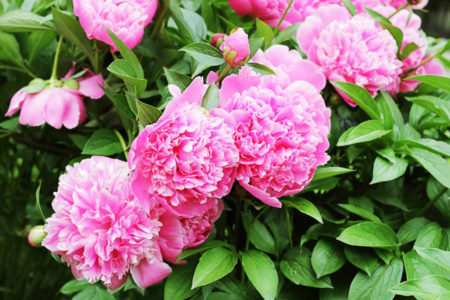
The process of pruning regular peony bushes is simple. This event is started when the foliage from the cold falls on the ground. Frosts start at different times depending on the climatic zone, so there is no specific date. You need to navigate by the appearance of a peony on your own site. The stem is cut off almost completely. It is only necessary that the stem sticks out of the ground by 2-4 centimeters.
Pruning a tree peony in the fall is done according to a different principle. Formative pruning is done when they want to make the bushes more beautiful, to increase the number of buds or the size of the flower, by removing the side shoots. The stems are shortened in height to a maximum of one meter. This will help the plants grow thicker and more flowering buds. In addition, cut off stems are much easier to cover before the winter cold.
You need to prune the tree peony for rejuvenation once every 10 years. If the bush does not bloom so densely or stops blooming altogether, then it is time to carry out a renewal pruning. Old shoots are removed, thereby provoking the growth of new ones. With systematic proper care, the life expectancy of shrubs is approximately 70 years.
Caring for peonies after pruning, feeding
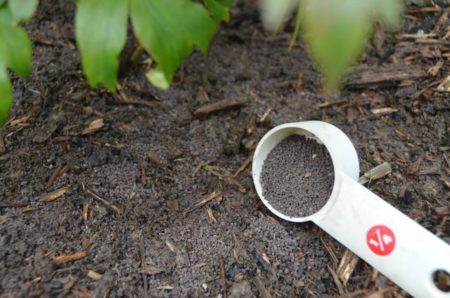
You need to feed peonies before winter dormancy 10-14 days before frost. This is approximately from the second half of September to the first half of October. Fertilizers are added on dry warm days
It is important that the top dressing contains phosphorus and potassium. These substances help the root system to grow and strengthen, giving it strength for a long period of rest.
Attention! Fertilizer should not contain nitrogen, because shrubs begin to quickly grow green mass from it, and in winter there is no need for this.
Top dressing methods:
- dry;
- liquid.
If the autumn turned out to be dry, then the fertilizers are stirred in water and poured under the roots. In a rainy autumn, the granules are scattered around the stems, tamping them a little into the soil, or sprinkle top dressing on the ground, loosened with a rake.
The positive effect of such feeding
Some growers consider this method of plant feeding meaningless, but it has its advantages:
- By the next season, the kidneys become stronger.
- Flowering is more intense.
- The flowers are larger, and the color is richer and brighter.
- Thanks to phosphorus and potash fertilizers, plants can better tolerate winter cold and germinate more hardy and strong.
Common mistakes when preparing for winter
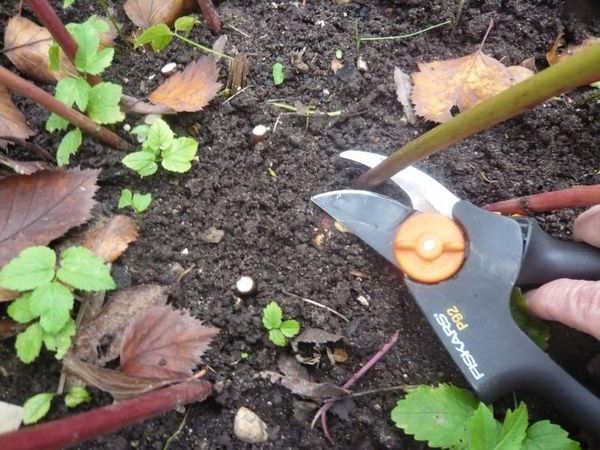
Peonies are very unpretentious plants, they do not require constant attention, in the summer it is enough just to water them. Most often, even fertilizers are applied exclusively in spring and autumn. Most of the manipulations are carried out with them in the fall in preparation for winter.
It is important to avoid mistakes here, as they can have serious consequences.
After pruning, you cannot cover the roots with the same leaves - the result will be the same, pests and pathogenic microorganisms will happily overwinter and get stronger, but peonies, on the contrary, will weaken and get sick.
Pruning too early is a common mistake, as this will also weaken the plant. And sheltering not in accordance with the expected winter can completely lead the plant to death.
How to transplant peonies in the fall to a new place
The transplantation of young 1-2-year-old specimens is scheduled for early autumn. At the same time, watering must be included in the care of the plant. The stems of the peony are cut off, and the seedling with a clod of earth is transferred to a new place.
Planting adult peonies and caring for them in the fall is carried out according to the scheme for planting young denoks, but it is recommended to plant adult specimens only if necessary, when an urgent need to save the plant (rotten or deeply buried).
Seat selection
Peonies do well in areas where there is a lot of space and light, but there are no cold northerly winds. The groundwater level should be no higher than 1-1.5 m from the earth's surface. Stagnation of water is also not allowed, even for a short time.
Important! You can not plant a peony in a place where a tree or shrub grew, since their powerful roots greatly impoverish the earth
their powerful roots severely impoverish the earth.
In this case, it is worth enriching the composition of the soil or changing it. From buildings, a transfer is possible at a distance of 1.5 m.
Peonies prefer loamy soil (pH 7.0), heavy, but cultivated and well-drained. If the soil is over-acidified, add dolomite flour or lime.
Soil preparation
Representatives of the peony family are long-livers. They can grow in one place for more than 30 years, but after 5-6 years they need a transplant. The upper soil layer is rich in humus, biologically active, but the lower one is significantly depleted during this time.
Powerful rhizomes of peony penetrate into the soil depth up to 1 m, 80-100 cm wide. The depth of the holes dug for them is 60 cm, the width is within 60-80 cm. The cuttings are transplanted into the prepared fertile soil.
Any organic matter (humus, peat) and mineral salts (200 g of superphosphate and the same amount of potassium sulfate) are introduced to 2/3 of the depth of the pit.
If the soils are acidic, add 200 g of slaked lime. In the case of clay soil, 0.5 buckets of sand.
The top of the pit is filled up with earth taken from the upper soil layer.
Planting flowers
Before transplanting peonies in the fall, you need to dig them up in a certain way:
Before removing the root, cut the stems at a height of 15 cm from the ground
Digging up large bushes is not easy, because the roots go down to a meter depth
They are dug in at first in a circle, and then, swinging, they are carefully removed from the soil. Leave the plant alone for 2 hours so that the rhizomes become lethargic and do not break when dividing
The rhizome is not cut, but carefully separated into several parts, trying not to harm the buds of renewal. Long roots are cut to 20 cm at a 45 ° angle. Each divided bush should have at least 3-5 eyes and the same number of young or shortened old roots. Sections before planting are treated with colloidal sulfur or crushed coal
It is advisable to disinfect with copper sulfate (15%).
After the preparatory measures, a transplant is performed:
- soil is poured into the previously harvested planting pits (60 cm wide and 50 cm deep);
- plant a plant, sprinkle it with an upper earthen layer and, slightly pressing, ensure its snug fit to the soil;
- peonies during transplantation should not be deeply buried. Otherwise, they will not bloom. A shallow planting is also detrimental to them, since the opening of the renewal buds will result in damage to the root collar from above;
- the depth of the growth buds should be 3-5 cm on heavy and no more than 5-7 cm on light soils, so it is best to prepare the pits a month before transplanting, so that the earth settles well;
- actively water the flowers before the soil subsides;
- over time, the buds become bare, and to protect them from the winter cold, they are covered with a substrate 10-15 cm thick.
How the process of transplanting a peony in the fall is discussed in the video:
Caring for peonies in the fall and preparing for winter
In the summer, caring for peonies consists in timely watering and loosening, top dressing, weeding and removal of fading buds. With the onset of autumn, the care regimen for herbaceous and tree-like peonies changes.
Top dressing and watering
To ensure abundant and long-lasting flowering, the plants are watered regularly and abundantly; after the buds wither, watering should be reduced
Peony roots continue to grow and develop until the very cold, so it is important to feed them in the fall two weeks before the temperature drops below 0ºC. In the middle lane, this period occurs at the beginning of October, and in the south - at the end of November.
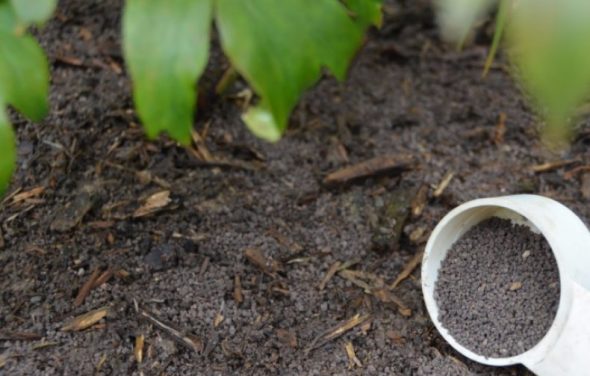
Top dressing of peonies should be carried out before the onset of frost
It is advisable to apply potassium-phosphorus fertilizers in warm and dry weather, then they will give the desired support:
- help to strengthen the root system for better winter hardiness;
- in the next season, the flowers will become larger and brighter;
- stronger buds are formed, the plant will be strong and healthy in spring.
Dry granules are scattered around the bush, and during the autumn rains, nutrients will gradually enter the soil. In dry weather, it is recommended to use a liquid top dressing, pouring 1 liter of the composition under each bush. Treelike varieties are fertilized in the same way.
Pruning
It is important to choose the right time for pruning peonies. This work is carried out in two stages:
-
the first pruning is done in summer, after flowering. Only dried flowers and branches need to be removed, healthy leaves are left, with the help of photosynthesis occurring in them, the plant will accumulate useful substances and recover after flowering;
-
when the first frost hits and the foliage of the peony falls on the ground, you can carry out a second pruning. In regions with different climates, this can happen at different times. With garden shears or pruning shears, the stems are cut 2-3 cm above the soil level. Pruning early will strip the foliage and interfere with the absorption of nutrients from the soil.
Some gardeners believe that this procedure can be postponed until spring, but in this case, the larvae of pests and microspores of fungi will overwinter in the rotting leaves, and the flowers will be small next year.
Pruning tree peonies in the fall has two important functions:
- formation;
- rejuvenation.
As a result of pruning, you will get a beautiful bush shape, a larger number of young branches, and intense flowering. The height of the cut of the shoots is 0.7–0.9 m, which makes it easier to hide for the winter. Treelike peonies need to be rejuvenated no more than once every 10 years, by which time flowering usually fades away or stops, and the bushes grow worse. Pruning is carried out in the autumn and old shoots are removed and new ones are stimulated.
Hilling
It is imperative to spud the plant and hide the bare stems and the growing point, which in the peony is at a depth of no more than 6 cm from the surface of the earth. Plants are covered with dry earth mixed with sand in warm weather. It is useful to sprinkle ash on the soil around the plant and on the cuts of the stems, this will serve as protection against various infections and rotting.
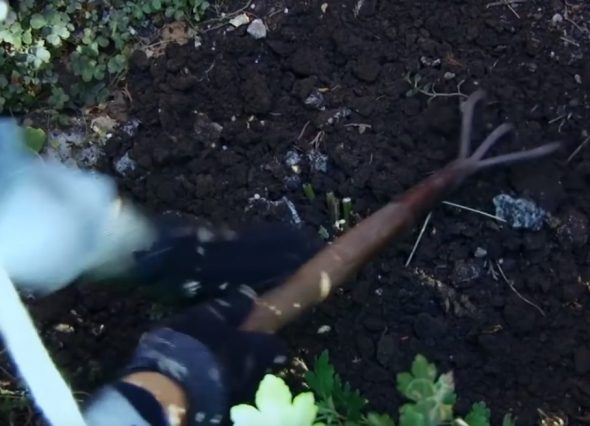
When hilling, the bare stems and the growth point must be hidden at a depth of no more than 6 cm
Warming
Fed and cut seedlings can be insulated. For shelter or mulching, the following materials are suitable:
- dry sawdust;
- spruce branches;
- compost;
- high-moor peat;
- dry foliage.
You can not cover peonies with cut branches and leaves from a bush, it is advisable to burn them in order to destroy pests and pathogenic microbes.
The layer of mulch should be at least 20 cm in order to provide sufficient protection from frost, on top you can cover the bushes with cardboard boxes or old plastic buckets, cover with snow from the paths. These activities will help the peony winter successfully.
Treelike peonies in regions with a mild climate do not need to be covered if they grow in a quiet corner of the garden. Seedlings need protection, if the winter is frosty, with strong winds, little snow
After pruning, the shoots are bent to the ground and carefully fixed so as not to break. Agryl, spunbond, spruce branches are used as a covering material.
Snow will serve as an excellent additional insulation.
Video: how to prepare peonies for winter
Some gardeners do not carry out preparatory work for wintering peonies, but if all the recommendations of experts are followed, the frost will not harm the plants and next spring the peonies will bloom again in lush fragrant clouds and will hurt less, and tree varieties will live up to 60-80 years.
Separation and transplant
Peonies do not like to change their habitat often. They grow well and bloom in one place for up to 10 years. But if the bush has grown a lot, the soil has become impoverished, then he will have to move. And it is best to choose the autumn period for this.
There are no exact dates, it all depends on the current weather forecast and the region. In the Volga region, the first snow falls at the end of October, severe frosts begin around the 20th. For adaptation and rooting, the peony will need at least 1-1.5 months, which means that you should not delay with the planned event. I leave this work at the very beginning of September.
To plant my favorite flowers, I choose a warm, clear day. 2-3 days before the planned transplant, the flowerbed is generously watered and then the roots are easily dug out and separated without unnecessary injuries.
Then I wash them, examine them, remove old, damaged or rotten ones. For disinfection, I put it in a light pink solution of potassium permanganate for half an hour and only after that I divide it into several parts, leaving young roots with already formed kidneys.
I prepare the garden for them in advance, again choosing a well-lit place. I pour 50 g of superphosphate into the soil, 1-2 buckets of humus and carefully dig it up. If the soil is heavy, add 1 bucket of sand and 1-2 glasses of ash.
I prefer to plant peonies in trenches, single plantings are more difficult to cover and water. The depth is no more than 40-50 cm, I try to take it in width with a margin, so as not to crumple the roots.
When planting, it is important to observe the measure and leave the upper bud of the young shoot above the ground, but not higher than 1-2 cm.Watering of the planted bushes is carried out 2-3 times a week
During the rainy season, the amount of moisture is adjusted.
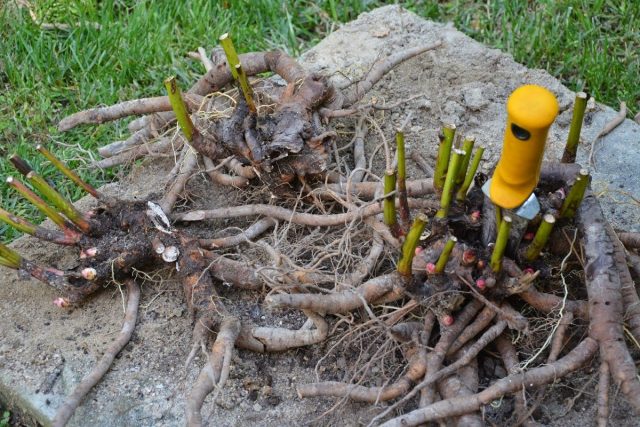 Separating and replanting peonies is best in autumn. Southern peony
Separating and replanting peonies is best in autumn. Southern peony


